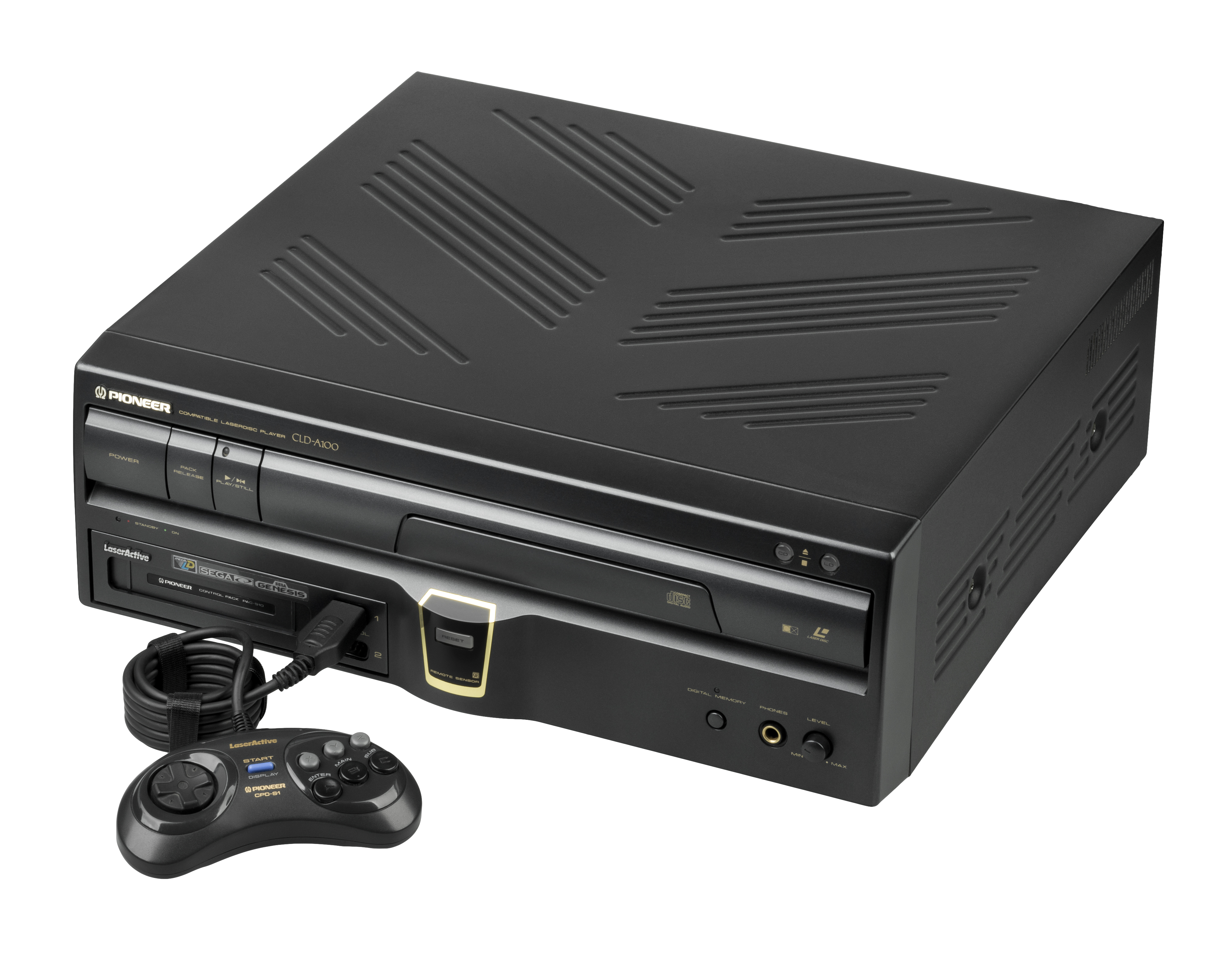|
LaserActive
The is a converged device and fourth-generation home video game console capable of playing LaserDiscs, Compact Discs, console games, and LD-G karaoke discs. It was released by Pioneer Corporation in 1993. In addition to LaserActive games, separately sold add-on modules (called "PACs" by Pioneer) accept Mega Drive/Genesis and PC Engine/TurboGrafx-16 ROM cartridges and CD-ROMs. Pioneer released the LaserActive model CLD-A100 in Japan on August 20, 1993, at a cost of ¥89,800, and in the United States on September 13, 1993, at a cost of $970. An NEC-branded version of the LaserActive player known as the LD-ROM² System, or model PCE-LD1, was released in December 1993, which was priced identically to the original system and also accepted Pioneer's PAC modules. The LaserActive has no regional lockout, allowing software from any region to be played on any system. Accessories PAC modules In the headings below, the Japanese model number occurs first, followed by the North American ... [...More Info...] [...Related Items...] OR: [Wikipedia] [Google] [Baidu] |
Sega Genesis
The Sega Genesis, known as the outside North America, is a 16-bit Fourth generation of video game consoles, fourth generation home video game console developed and sold by Sega. It was Sega's third console and the successor to the Master System. Sega released it in 1988 in Japan as the Mega Drive, and in 1989 in North America as the Genesis. In 1990, it was distributed as the Mega Drive by Virgin Mastertronic in Europe, Ozisoft in Australasia, and Tec Toy in Brazil. In South Korea, it was distributed by Samsung as the Super Gam*Boy and later the Super Aladdin Boy. Designed by an Research and development, R&D team supervised by Hideki Sato and Masami Ishikawa, the Genesis was adapted from Sega's Sega System 16, System 16 arcade board, centered on a Motorola 68000 processor as the central processing unit, CPU, a Zilog Z80 as a sound controller, and a video system supporting hardware Sprite (computer graphics), sprites, Tile-based video game, tiles, and scrolling. It plays a List ... [...More Info...] [...Related Items...] OR: [Wikipedia] [Google] [Baidu] |
Sega CD
The Sega CD, released as the in most regions outside North America and Brazil, is a CD-ROM accessory for the Sega Genesis produced by Sega as part of the fourth generation of video game consoles. It was released on December 12, 1991, in Japan, October 15, 1992, in North America, and April 2, 1993, in Europe. The Sega CD plays CD games and adds hardware functionality such as a faster CPU and graphic enhancements such as sprite scaling and rotation. It can also play audio CDs and CD+G discs. Sega sought to match the capabilities of the competing PC Engine CD-ROM² System, and added an additional CPU and custom graphics chip. They partnered with JVC to design the Sega CD. Fearful of leaks, Sega refused to consult with Sega of America until the project was complete; Sega of America assembled parts from dummy units to obtain a functioning unit. The Sega CD was redesigned several times by Sega and licensed third-party developers. The main benefit of CD technology at the time ... [...More Info...] [...Related Items...] OR: [Wikipedia] [Google] [Baidu] |
LD-ROM
LV-ROM is an optical disc format developed by Philips Electronics to integrate analog video and computer software for interactive multimedia. The LV-ROM is a specialized variation of the CAV Laserdisc. ''LV-ROM'' is an initialism for "LaserVision Read-Only Memory". Like Laserdisc, LV-ROM discs store analog audio and video by encoding it in pulse-width modulation. However, LV-ROM also stores computer files via the Advanced Disc Filing System, which is the file system used by Acorn Computers. An LV-ROM disc can store up to 324 megabytes of digital information, or up to 54,000 frames of analog video (36 minutes with a frame rate of 25 fps) per side. The format had only one application: to publish documentary video, children's writings, and other historical records compiled from 1984 to 1986 for the BBC Domesday Project. The Domesday Project LV-ROM discs were played using a BBC Master computer connected via SCSI-1The BBC Master, introduced by Acorn Computers in 1986, was one of the ... [...More Info...] [...Related Items...] OR: [Wikipedia] [Google] [Baidu] |
History Of Video Game Consoles (fourth Generation)
In the history of video games, the fourth generation of game consoles, more commonly referred to as the 16-bit era, began on October 30, 1987, with the Japanese release of NEC Home Electronics' PC Engine (known as the TurboGrafx-16 in North America). Though NEC released the first console of this era, sales were mostly dominated by the rivalry between Sega and Nintendo across most markets: the Sega Mega Drive (''Sega Genesis'' in North America) and the Super Nintendo Entertainment System (SNES; ''Super Famicom'' in Japan). Cartridge-based handheld consoles became prominent during this time, such as the Nintendo Game Boy (1989), Atari Lynx (1989), Sega Game Gear (1990) and TurboExpress (1990). Nintendo was able to capitalize on its success in the previous, third generation, and managed to win the largest worldwide market share in the fourth generation as well. Sega, however, was extremely successful in this generation and began a new franchise, Sonic the Hedgehog, to com ... [...More Info...] [...Related Items...] OR: [Wikipedia] [Google] [Baidu] |
Active Shutter 3D System
An active shutter 3D system (a.k.a. alternate frame sequencing, alternate image, AI, alternating field, field sequential or eclipse method) is a technique of displaying stereoscopic 3D images. It works by only presenting the image intended for the left eye while blocking the right eye's view, then presenting the right-eye image while blocking the left eye, and repeating this so rapidly that the interruptions do not interfere with the perceived fusion of the two images into a single 3D image. Modern active shutter 3D systems generally use liquid crystal shutter glasses (also called "LC shutter glasses" or "active shutter glasses"). Each eye's glass contains a liquid crystal layer which has the property of becoming opaque when voltage is applied, being otherwise Transparency (optics), transparent. The glasses are controlled by a timing signal that allows the glasses to alternately block one eye, and then the other, in synchronization with the refresh rate of the screen. The timing s ... [...More Info...] [...Related Items...] OR: [Wikipedia] [Google] [Baidu] |
LD-G
LV-ROM is an optical disc format developed by Philips Electronics to integrate analog video and computer software for interactive multimedia. The LV-ROM is a specialized variation of the CAV Laserdisc. ''LV-ROM'' is an initialism for "LaserVision Read-Only Memory". Like Laserdisc, LV-ROM discs store analog audio and video by encoding it in pulse-width modulation. However, LV-ROM also stores computer files via the Advanced Disc Filing System, which is the file system used by Acorn Computers. An LV-ROM disc can store up to 324 megabytes of digital information, or up to 54,000 frames of analog video (36 minutes with a frame rate of 25 fps) per side. The format had only one application: to publish documentary video, children's writings, and other historical records compiled from 1984 to 1986 for the BBC Domesday Project. The Domesday Project LV-ROM discs were played using a BBC Master computer connected via SCSI-1The BBC Master, introduced by Acorn Computers in 1986, was one of th ... [...More Info...] [...Related Items...] OR: [Wikipedia] [Google] [Baidu] |
TurboGrafx-16
The TurboGrafx-16, known as the outside North America, is a home video game console designed by Hudson Soft and sold by NEC Home Electronics. It was the first console marketed in the fourth generation, commonly known as the 16-bit era, though the console has an 8-bit central processing unit (CPU) coupled with a 16-bit graphics processor. It was released in Japan in 1987 and in North America in 1989. In Europe, the console is known as the PC Engine, after the Japanese model was imported and distributed in the United Kingdom and France from 1988. In Japan, the system was launched as a competitor to the Famicom, but the delayed United States release meant that it ended up competing with the Sega Genesis and later the Super NES. The console has an 8-bit CPU and a dual 16-bit graphics processing unit (GPU) chipset consisting of a video display controller (VDC) and video color encoder. The GPUs are capable of displaying 482 colors simultaneously, out of 512. With dimensions of just ... [...More Info...] [...Related Items...] OR: [Wikipedia] [Google] [Baidu] |
LaserDisc
The LaserDisc (LD) is a home video format and the first commercial optical disc storage medium, initially licensed, sold and marketed as DiscoVision, MCA DiscoVision (also known simply as "DiscoVision") in the United States in 1978. Its diameter typically spans . Unlike most optical disc standards, LaserDisc is not fully Digital data, digital, and instead requires the use of analog video signals. Although the format was capable of offering higher-quality video and audio than its consumer rivals—VHS and Betamax videotape—LaserDisc never managed to gain widespread use in North America, largely due to high costs for the players and the inability to record TV programmes. It eventually did gain some traction in that region and became somewhat popular in the 1990s. It was not a popular format in Europe and Australia. By contrast, the format was much more popular in Japan and in the more affluent regions of Southeast Asia, such as Hong Kong, Singapore and Malaysia, and was the ... [...More Info...] [...Related Items...] OR: [Wikipedia] [Google] [Baidu] |
Home Video Game Console
A home video game console is a video game console that is designed to be connected to a display device, such as a television, and an external power source as to play video games. Home consoles are generally less powerful and customizable than personal computers, designed to have advanced graphics abilities but limited memory and storage space to keep the units affordable. While initial consoles were dedicated units with only a few games fixed into the electronic circuits of the system, most consoles since support the use of swappable game media, either through game cartridges, optical discs, or through digital distribution to internal storage. There have been numerous home video game consoles since the first commercial unit, the Magnavox Odyssey in 1972. Historically these consoles have been grouped into generations lasting each about six years based on common technical specifications. As of 2021, there have been nine console generations, with the current leading manufactu ... [...More Info...] [...Related Items...] OR: [Wikipedia] [Google] [Baidu] |
Floppy Disk
A floppy disk or floppy diskette (casually referred to as a floppy, or a diskette) is an obsolescent type of disk storage composed of a thin and flexible disk of a magnetic storage medium in a square or nearly square plastic enclosure lined with a fabric that removes dust particles from the spinning disk. Floppy disks store digital data which can be read and written when the disk is inserted into a floppy disk drive (FDD) connected to or inside a computer or other device. The first floppy disks, invented and made by IBM, had a disk diameter of . Subsequently, the 5¼-inch and then the 3½-inch became a ubiquitous form of data storage and transfer into the first years of the 21st century. 3½-inch floppy disks can still be used with an external USB floppy disk drive. USB drives for 5¼-inch, 8-inch, and other-size floppy disks are rare to non-existent. Some individuals and organizations continue to use older equipment to read or transfer data from floppy disks. Floppy di ... [...More Info...] [...Related Items...] OR: [Wikipedia] [Google] [Baidu] |


.jpg)




